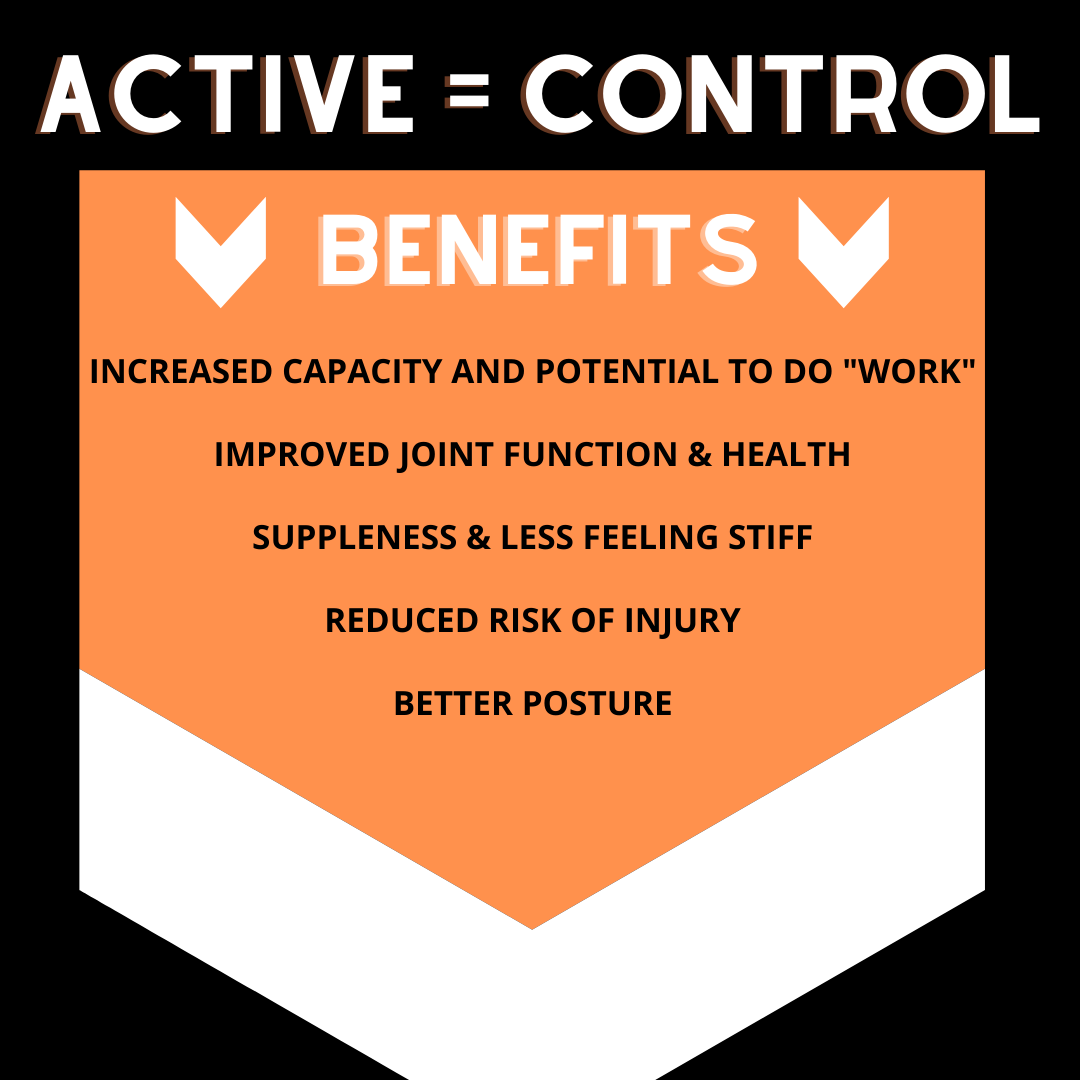What is Active Range of Motion (AROM)? Why is it important and how does it help mitigate injuries?
“If you can’t control a specific range, you likely don’t truly “own” that range.”
Some of us may have heard that we have great or perhaps…er…less than great range of motion. Maybe this is due to an old injury in which you found you had less motion after, some overuse issues, or a fall during an activity. Or perhaps you woke up one day looking back and noticed you just don’t bend like you used to.
Regardless, we all have some degree of range of motion…
What is range of motion (ROM)?
Range of motion (ROM) can simply mean the amount of movement or space you possess to move within a joint. This can be further broken up into passive range of motion (PROM) and active range of motion (AROM), though other distinctions exist.
It’s worth mentioning that this ROM applies to major joints through the body like in the shoulders, hips, knees, ankles; and many smaller ones as well like your fingers and toes. A discussion of joints and joint types is beyond this article, but it is safe to say that all joints are meant to have a certain amount (or lack) of range that would be considered “normal”.
What is ACTIVE range of motion or AROM?
Active range of motion simply means that YOU are able to actively CONTROL your body through a desired movement or range of motion.
Ideally, you want to use your greatest range of motion often in order to maintain joint health. For example, laying with your back on the ground and engaging one leg to lift off the ground to achieve the greatest amount of hip flexion (shortening the space between your thigh and your torso) is considered active range of motion. If, however, you were to have your personal trainer lift your leg for you into a nice hamstring stretch, this would be considered a passive range of motion (PROM). At no point during that stretch did you actively control your leg into its greatest range of motion. Passive range is most always greater than active range, likely for obvious reasons, BUT it can be very beneficial to bridge the gap between the two o they are closer to the same amount of range. This usually never works out to be a 1:1 relationship of active to passive, but ideally we want to work to increase our range WITH control.
Why is Active Range of Motion Important?
Many of us use assistance and external aids (bands, yoga straps, etc.) to achieve greater ranges of motion (which can be fine by the way). Unfortunately, years down the road if using those modes exclusively, you might notice a decrease in your ability to access certain movements during your workouts and effortful pursuits or how well you can perform them. Even though that aid is able to get you in the position otherwise, you are now asking your muscles and soft tissues to bring you into that position/range and they may not be able. Maybe you feel tight in your back or hips as you drop into a squat with weight that you can normally pull yourself into with hand support; or perhaps feel limited when you push that kettlebell into an overhead press. This can be a problem.
Remember that old saying, if you don’t use it, you lose it? …Turns out that is somewhat accurate much to our dismay. Many of us may not be able to work out regularly at all or only work out for an hour, 2-3x a week. That’s maybe 3 hours out of 168 hours in a week. During that total time, how often are you reaching your active end range in all joints of your body? Are you heavily focused on it in those 3 hours should you have them?
If you rarely ACTIVELY take your shoulder into its safest but greatest range of motion frequently you will likely, over time, lose the ability to access that active range of motion. After all, you cannot well maintain what you are not actively using.
Using Active Range of Motion to Avoid Injury?
As mentioned, if you can’t control a specific range, you likely don’t truly “own” that range.
Though you can stretch your way into a position after a minute or two, when it comes time to support load from your body or perhaps something external (i.e. a weight, box being lifted overhead to a cabinet or purse reached from the back seat of the car), if you cannot control it with your own active strength, you may be asking for injury. Conversely, if you CAN control load (and maybe even greater loads than being demanded of your body), you may just be able to stave off injury while also moving better…win, win.
But how do I figure this out, you ask?...Fairly simple.
Assess, Try it Out, Reassess
Assess your active range of motion in doing a movement. Injuries can happen when you exceed your active range of motion or perhaps get a more sudden load introduced that exceeds that ability to control. If your workout involves an overhead press then test your active range WITHOUT WEIGHT before adding weight.
Look for COMPENSATIONS and SENSATIONS. Actively move one arm straight out to over head and note anything other than your shoulder girdle and arm moving. Does your chest lift up before you reach the desired end of that range of motion? Are you arching your back or leaning with your head and neck to accommodate that movement? Maybe you are feeling tight in your back or top of your shoulder. Do you have pain in your neck or midback? These are all signs that hint towards whether you can actively achieve that range of motion required for that shoulder press or not.
Consider the next time you work out; if the movement requires you be able to actively use 180 degrees but you only own 150 degrees, then either change the movement to match the space and range you possess, or find a different exercise that will better suite your active range and may work to also expand it. When we can move under load in a way that allows us to explore greater range over time, we can eventually own more and more range. Think of it as graded exposure.
Just as with sudden injury (acute), chronic (over time) overload to an area that you do not possess the required active range of motion for will lead to your tissues and other structures beginning to breakdown from too much strain. We must reverse our way back out methodically.
How to Track Your AROM Progress
So how do we fix this and start our journey toward greater resiliency in our joints and tissues?
Increasing your available active range of motion takes time. The changes will be small and over the course of months (not days). DO NOT GET DISCOURAGED! We cannot stress this enough. This is normal. It takes countless repetitions to increase your active range of motion. If the joint you are working on is painful, expect it to take a little longer as you EXPLORE different areas of that joint perhaps once off limits while your BRAIN learns that it is indeed SAFE to be in that position now (or once again).
This “learning” and “re-learning” can be quicker for some and longer for others depending on may factors. Realize that though it will take time, as soon as you start, you have begun moving in the direction to a healthier joint with more active range.
The best way to see this change is to RECORD yourself doing a MOVEMENT. We will talk about what types of movements are best for measuring your progress in another post, but for now, record yourself doing a movement that is challenging. If possible, record it from an angle you can see the full range (possibly multiple angles like front, back, side, ¾ view) in slow-motion or view it in slow.
Take a look at your body and note where you might be compensating.
After some weeks or months doing specific training to increase your range of motion, record yourself again doing the same movement using the EXACT same parameters. You will notice a difference not only in the way the movement looks (increased range), but also the way it feels. Continue keeping track just as you would when recording your personal bests in your regular training program (and you just might find those happen elsewhere as well!).
If you are interested in learning more about your active range of motion or ways to increase your gains in the gym/outdoors, we will be creating more content around this and it is also something we specialize in. For a personally tailored approach, progression and feedback please drop us a line. We offer both in-person and remote sessions to show you how to access and move past your training plateaus using safe and targeted training so you can do it on your own as well.




